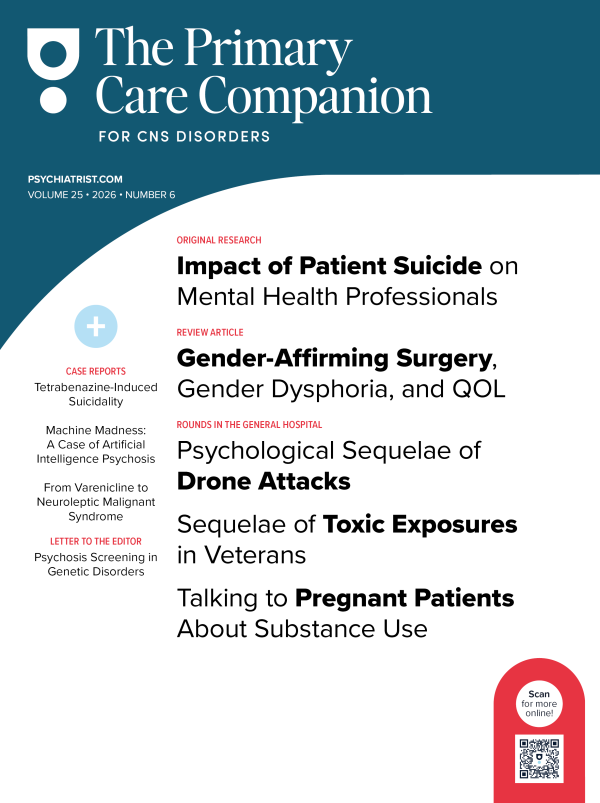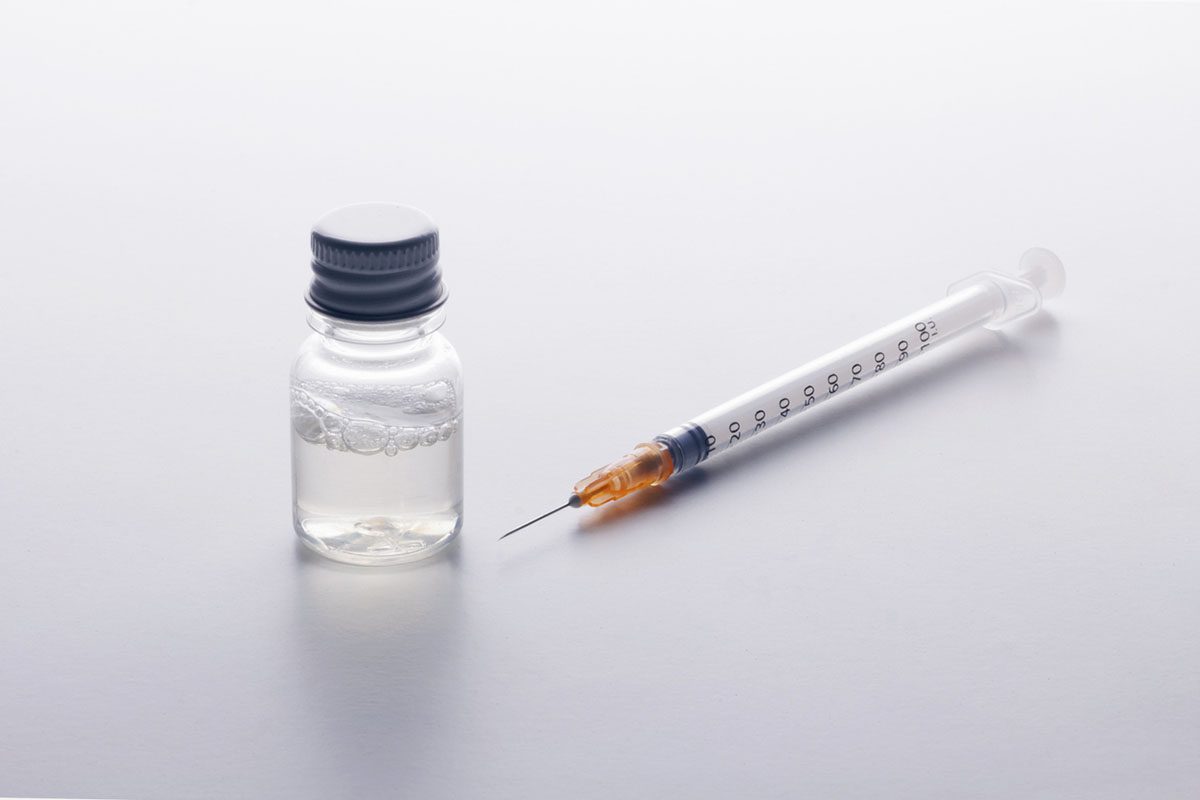Inpatient Detoxification From a Synthetic Cannabinoid and Control of Postdetoxification Cravings With Naltrexone
To the Editor: Synthetic cannabinoid use continues to increase. We report the case of a woman presenting with severe synthetic cannabinoid physical dependence, smoking "mojo" every 15 minutes during the day and awakening every 45 minutes in full withdrawal to smoke it overnight.
Case report. Ms A is a 39-year-old white woman seeking detoxification for mojo addiction. She had smoked mojo, a synthetic cannabinoid, for years, with a month-long increase in usage. During this time, she spent over $5,000 and cashed in her retirement and vacation time. She denies other substance use, has 1 distant psychiatric admission, has no history of suicide attempts or psychiatric diagnoses, and is not taking any medications.
Ms A was admitted to the detoxification unit and started on phenobarbital to control anxiety and discomfort with seizure prophylaxis, as she had not gone more than 2 hours without smoking mojo in months. Laboratory assessments revealed malnutrition, and the urine toxicology screen was positive for cocaine, which Ms A adamantly denied using. Ms A’s vital signs were assessed every 4 hours, and she was started on a phenobarbital taper of 100 mg by mouth 3 times daily and escitalopram 10 mg for anxiety and depression. She was prescribed when-needed clonidine 0.1 mg for withdrawal symptoms, tizanidine 8 mg for cramping, and metoclopramide 10 mg for nausea. Dietary services was consulted and recommended soup and crackers and cyproheptadine 8 mg 4 times daily for appetite stimulation.
At admission, Ms A had a blood pressure of 161/91 mm Hg and a pulse of 68 bpm. Day 1 pulse values ranged from 64 to 75 bpm, with systolic blood pressure from 133 to 186 mm Hg over diastolic blood pressure from 91 to 102 mm Hg. Day 2 pulses ranged from 72 to 81 bpm, with systolic blood pressure from 130 to 158 mm Hg and diastolic blood pressure from 79 to 102 mm Hg. As her vital signs normalized, phenobarbital was tapered to 60 mg 3 times daily. Day 3 pulse values ranged from 64 to 79 bpm, with systolic blood pressure ranging from 123 to 145 mm Hg and diastolic blood pressure from 86 to 91 mm Hg. For cravings, naltrexone 25 mg daily was initiated on day 3 and was well tolerated. On day 6, phenobarbital was titrated to 30 mg 3 times daily and escitalopram to 20 mg daily. When Ms A was discharged on day 7, her vital signs normalized (heart rate: 78 bpm, blood pressure: 124/84 mm Hg), phenobarbital was discontinued, and naltrexone was increased to 50 mg daily. She reported a dramatic decrease in cravings, and escitalopram was continued at 20 mg daily.
Despite laws blocking production and sale of synthetic cannabinoid-1 receptor (CB1R) agonists, compounds like mojo are spreading and undetectable.1 Most CB1R agonists are distinct from partial agonist tetrahydrocannabinol and are high-potency full agonists at CB1R. Synthetic CB1R agonists are the second-highest recreationally used illicit substance after cannabis among 12th graders.2 A parallel increase of calls to poison control centers, emergency care, and hospitalization underscores the potentially serious negative consequences associated with synthetic cannabinoid use.3 Synthetic cannabinoids appeared in the Drug Abuse Warning Network in 2010 and were involved in 11,406 emergency department visits.4 In 2011, 28,531 emergency department visits involved synthetic cannabinoids, a 150% 1-year increase.4 Use of synthetic cannabinoids has led to the description of dependence and withdrawal symptoms.4 Cannabis dependence develops insidiously in some people5; the greater potency of synthetic cannabinoids at CB1Rs can produce dependence more expeditiously with clearer withdrawal syndrome.6 Barbiturates were used in this case report, but benzodiazepines and β-blockers can be used for sinus tachycardia, blood pressure, and anxiety.
Preclinical studies demonstrate a bidirectional modulatory relationship between opioid and cannabinoid systems7 and suggest that the opioid system contributes to subjective experiences of cannabis intoxication.8 No studies exist evaluating naltrexone in patients dependent on synthetic cannabinoids; evidence suggests that naltrexone reduces anxiety and depression rates, increases functioning, and is well tolerated during cannabis withdrawal.9 Our case demonstrates that synthetic CB1R agonists can cause severe withdrawal symptoms, and naltrexone appears to be a potential option to control cravings. Further study is needed.
References
1. Anderson E. Synthetic forms of marijuana outlawed in Louisiana. The Times Picayune [Newspaper]. http://www.nola.com/politics/index.ssf/2010/06/synthetic_forms_of_marijuana_o.html. Updated June 29, 2010. Accessed August 15, 2013.
2. Johnston LD, O’ Malley PM, Bachman JG, et al. Monitoring the Future National Results on Drug Use: 2012 Overview, Key Findings on Adolescent Drug Use. Ann Arbor, MI: Institute for Social Research, The University of Michigan; 2013.
3. Spaderna M, Addy PH, D’ Souza DC. Spicing things up: synthetic cannabinoids. Psychopharmacology (Berl). 2013;228(4):525-540. PubMed doi:10.1007/s00213-013-3188-4
4. DAWN. National Estimates of Drug-Related Emergency Department Visits. Rockville, MD: Substance Abuse and Mental Health Services Administration Drug Abuse Warning Network; 2013.
5. Wagner FA, Anthony JC. From first drug use to drug dependence; developmental periods of risk for dependence upon marijuana, cocaine, and alcohol. Neuropsychopharmacology. 2002;26(4):479-488. PubMed doi:10.1016/S0893-133X(01)00367-0
6. Nacca N, Vatti D, Sullivan R, et al. The synthetic cannabinoid withdrawal syndrome. J Addict Med. 2013;7(4):296-298. PubMed doi:10.1097/ADM.0b013e31828e1881
7. Robledo P, Berrendero F, Ozaita A, et al. Advances in the field of cannabinoid: opioid cross-talk. Addict Biol. 2008;13(2):213-224. PubMed doi:10.1111/j.1369-1600.2008.00107.x
8. Cooper ZD, Haney M. Opioid antagonism enhances marijuana’s effects in heavy marijuana smokers. Psychopharmacology (Berl). 2010;211(2):141-148. PubMed doi:10.1007/s00213-010-1875-y
9. Shoenfeld N, Bodnik D, Rosenberg O, et al. Six-month follow-up study of drug treatment for cannabis addiction: comparison study of four drugs [article in Hebrew]. Harefuah. 2011;150(12):888-892, 937. PubMed
Author affiliations: Baylor College of Medicine (Drs Rodgman and Verrico) and Michael E. DeBakey Medical Center (Dr Rodgman), Houston, Texas; River Oaks Hospital New Orleans, Louisiana (Dr Worthy); and William Carey University College of Osteopathic Medicine, Hattiesburg, Mississippi (Ms Lewis).
Potential conflicts of interest: Dr Rodgman is a MIRECC fellow at the Michael E. DeBakey Medical Center, Houston, Texas, and his work and research are funded by the Department of Veterans Affairs. Drs Verrico and Worthy and Ms Lewis report no conflicts of interest related to the subject of this letter.
Funding/support: None reported.
Published online: August 14, 2014.
Prim Care Companion CNS Disord 2014;16(4):doi:10.4088/PCC.13l01594
© Copyright 2014 Physicians Postgraduate Press, Inc.





